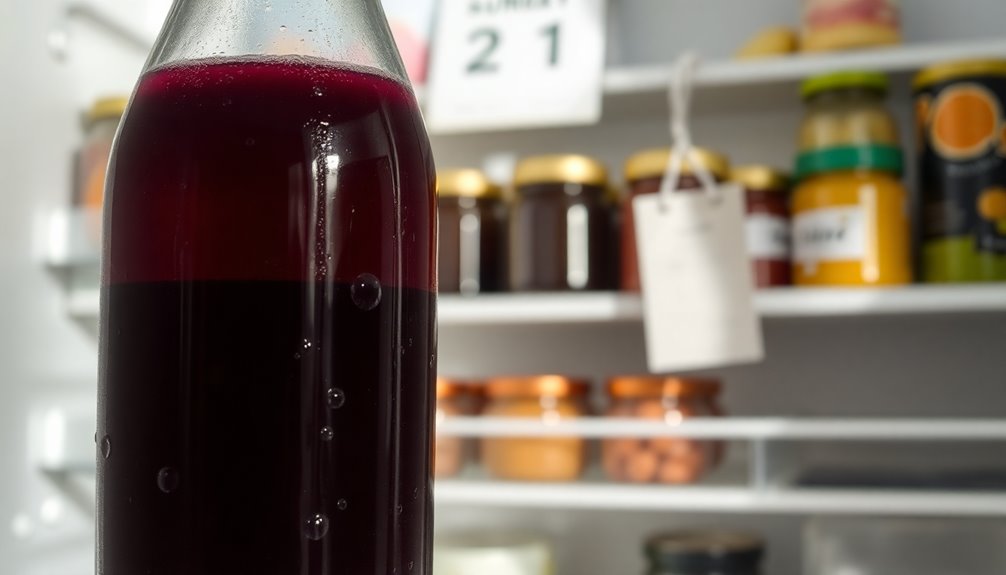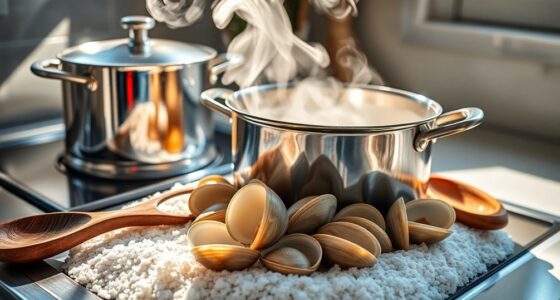Opened grape juice is good for about 7 to 10 days in the fridge. To keep it fresh, make sure to seal it tightly and store it around 40°F (4°C). Unopened grape juice can last 6 to 12 months, depending on preservatives. Keep an eye out for darkening, sour smells, or mold, which indicate spoilage. Want to know more about how to store grape juice properly? There's plenty more useful info ahead!
Key Takeaways
- Opened grape juice lasts about 7 to 10 days in the fridge for optimal freshness.
- Unopened grape juice can remain good for 6 to 12 months in the fridge.
- Always seal opened grape juice tightly to preserve its quality.
- Signs of spoilage include darkening, sour smells, off-flavors, and visible mold.
- Regularly check the juice's condition before consuming to avoid unpleasant experiences.

Have you ever wondered how long grape juice lasts in your fridge? It's a common question, especially if you enjoy sipping on this delicious beverage but don't always finish the bottle. Whether you've opened a bottle or are considering how long you can keep an unopened one, knowing the right storage conditions is key to ensuring your grape juice stays fresh and flavorful.
When it comes to opened grape juice, you can typically store it in the refrigerator for about 7 to 10 days while maintaining its best quality. This timeframe is crucial because, after this period, the juice may start to lose its optimal flavor. To keep your opened grape juice in the best shape possible, make sure you seal it tightly after each use and store it at around 40°F (4°C). This temperature helps slow down bacterial growth, ensuring that your juice remains safe and palatable for as long as possible.
If you've got an unopened bottle of grape juice, you're in luck! These can last anywhere from 6 to 12 months in the fridge, depending on the presence of preservatives. The preservatives help extend the shelf life, allowing you to enjoy your grape juice without worrying about it spoiling too soon. Just remember that the quality may start to decline as it approaches the end of this timeframe, so it's wise to keep an eye on the dates and consume it within that window.
However, regardless of whether your grape juice is opened or unopened, you should always watch out for spoilage signs. If you notice any darkening of the juice, sour smells, off-flavors, or even visible mold, it's time to toss it out. These indications suggest that the juice has gone bad, and consuming it could lead to unpleasant experiences. Trust your senses—if something seems off, it's better to err on the side of caution.
For the best experience when drinking grape juice, make a habit of checking the condition of your juice regularly. If you find a bottle that's been sitting in your fridge for a while, don't hesitate to give it a sniff or a taste before pouring a full glass. This simple act can save you from sampling something that's no longer enjoyable.
Frequently Asked Questions
Does Grape Juice Go Bad in the Fridge?
Yes, grape juice can go bad in the fridge.
If you notice darkening, a sour smell, off-flavors, or visible mold, it's best not to drink it. Proper storage in an airtight container helps extend its freshness, but even then, it won't last forever.
Keep an eye on its appearance and smell to ensure you're enjoying it at its best. Trust your senses—if it seems off, it probably is!
How Long Can You Keep Opened Juice in the Fridge?
You'll find that most opened juices can last about 7 to 10 days in the fridge.
To keep your juice fresh, store it tightly sealed at or below 40°F (4°C).
Check for any signs of spoilage, like off odors or discoloration, before drinking.
Remember, keeping it in the main compartment helps avoid temperature fluctuations, ensuring your juice stays tasty for as long as possible.
Enjoy your refreshing drink!
How Long Can You Preserve Grape Juice?
You can preserve grape juice for varying lengths depending on its type.
Unopened store-bought juice with preservatives can last 8 to 12 months in a cool, dark place.
If it's organic or preservative-free, you've got about 6 to 8 months.
Homemade juice, however, should be consumed within 3 to 5 days.
Once you open it, the freshness diminishes quickly, so try to enjoy it within a week for the best taste.
How Long Does It Take for Grape Juice to Turn Into Wine?
"Good things come to those who wait."
When you're turning grape juice into wine, it usually takes about 1 to 2 weeks for the initial fermentation to kick off, where yeast converts sugars into alcohol.
After that, you'll have a secondary fermentation phase that can last several months, allowing the flavors to develop fully.
Conclusion
In conclusion, keeping your grape juice in the fridge is a smart move, but it doesn't last forever. Generally, you can enjoy it for about 7 to 10 days after opening, while unopened juice can last much longer. So, why let that delicious nectar go to waste? Make it a point to savor it before it loses its charm. After all, good things are meant to be enjoyed, not left to languish on the shelf!
Cindy thoroughly researches juicing trends, techniques, and recipes to provide readers with practical advice and inspiration. Her writing style is accessible, engaging, and designed to make complex concepts easy to understand. Cindy’s dedication to promoting the advantages of juicing shines through her work, empowering readers to make positive changes in their lives through the simple act of juicing.











